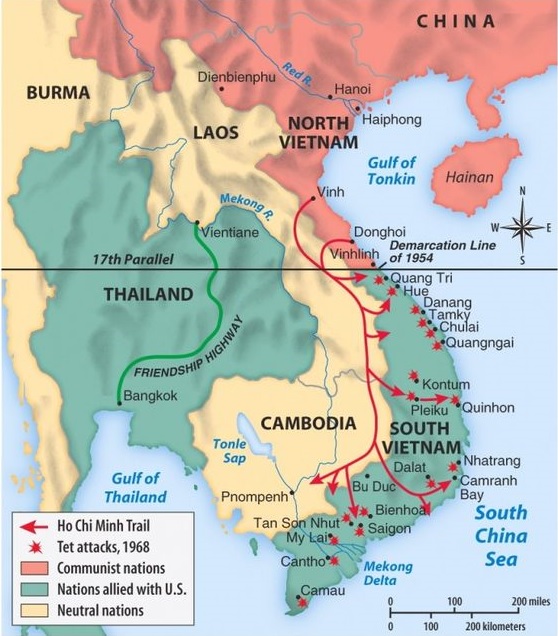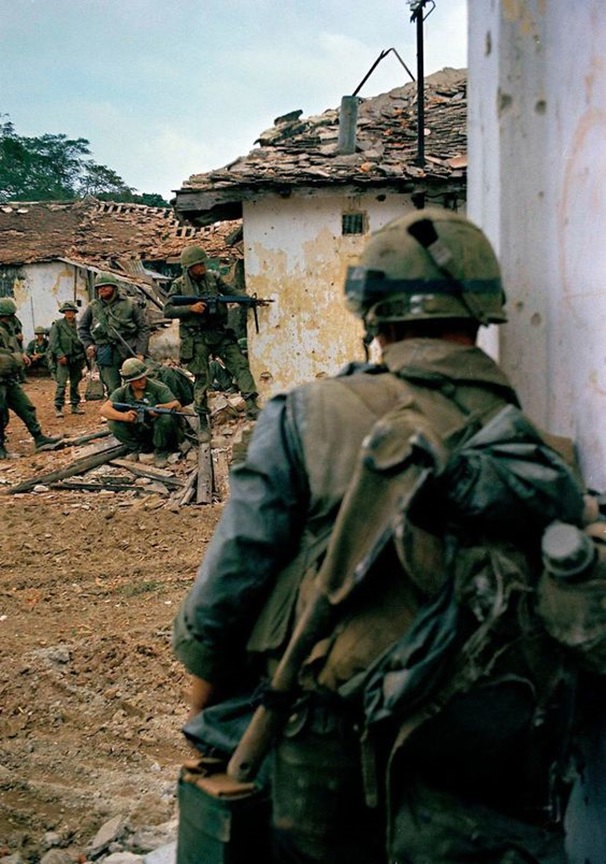

Table of Contents
The Vietnam War before the Tet Offensive
The most iconic conflict of the Cold War era is undoubtedly the Vietnam War (1955-1975) otherwise known as the Second Indochina War. The fighting was spread across Vietnam, Laos, and Cambodia, with substantial civilian and military casualties of the local population with some estimates going over 4 million deaths. The Vietnam War was in all senses a continuation of the First Indochina War (1946-1954) in which Vietnam was divided along the 17th parallel, with the communist rule in the north and anti-communist government in the south. According to the Geneva Conference, two states were supposed to unite after a countrywide election in 1956. However, the US feared that sooner rather than later the Communist Party of Vietnam would take over the entire country, causing a domino effect and dragging the surrounding states to fall under communist rule. Because of the domino theory, the Americans backed South Vietnam to opt-out of the election. It caused a severe reaction from the North Vietnamese, who began first covert operations in late 1956, starting the Vietnam War. Almost immediately the USSR and China began supporting North Vietnam, while the US aided the South. Thus, the war quickly attained its Cold War nature, as a confrontation of two blocks and two ideologies. Here it is vital to note that both Vietnamese states were autocratic and oppressive, despite the propaganda both sides spread to further their cause.
As such, the war was initially a proxy conflict of the capitalist and communist blocks. However, the north seemed to be more successful, prompting the slow yet steady increase of both financial and military involvement of the US. However, direct military participation was avoided until President Johnson came to power after Kennedy’s assassination. Tanks to the Gulf of Tonkin incident, a largely falsified confrontation between a North Vietnamese and a US vessel, in late 1964 the US Congress allowed Johnson to use all means necessary in the altercation with North Vietnam. The bombing began almost immediately, aimed at North Vietnam, as well as Cambodia and Laos, as the North Vietnamese used their territories to supply and transport their troops to South Vietnam. By March 1965 first US active combatants arrived in Vietnam, further escalating the war. Most of the world, including the US Homefront, expected it to be an easy victory as the US had a clear advantage over the North Vietnamese. However, the guerilla tactics used by the Vietnamese proved to be too elusive for the US military, and the war dragged on. According to the US plans their victory should have been achieved by early 1968, yet no clear progress had been made by that point, while the American armed presence continued to grow.

Map of Vietnam War, including the battles of Tet Offensive pinterest.
Outlines of the Vietnamese assault
In stark contrast to the mentioned US plans, the North Vietnamese were far from surrendering. In fact, by late 1967 they were planning a large offensive of their own. They planned to launch a wide coordinated attack on several important points in South Vietnam, hoping to inspire a national uprising against the American presence as well as the military junta which ruled in the south. The attack was launched on January 30th 1968, during the most important Vietnamese holiday known as Tet. It was the celebration of their lunar new year, which meant a substantial number of South Vietnamese soldiers were on leave. Neither the Americans nor their South Vietnamese allies expected such a grand offense on an important holiday which was also celebrated in North Vietnam. Furthermore, the US command doubted the communist troops would abandon guerilla tactics for head-to-head combat against them on a large front. Using the element of surprise, the North Vietnamese and their southern insurgents known as Viet Cong, attacked several important cities, including southern capital Saigon, as well as cities of Hue, Khe Sanh, Da Nang, and many others.
The fighting lasted for several weeks, as the North Vietnamese proved their grith against the superior enemy. However, as the initial shock of the attack weaned, the US troops began to regain their positions. It turned out that the Vietnamese made several miscalculations. First of all, they underestimated the maneuverability of the US troops, which were by then versed in the use of helicopters. That allowed them to quickly transport their troops after securing one part of the front to fight against the attackers on another. Furthermore, by spreading out their forces too widely, the North Vietnamese weakened their assault capabilities. However, the biggest mistake was the expectation of a nation-wide uprise, which never happened. Without the mass support of locals fighting against the US and their puppet regime, the offensive was doomed to fail. Furthermore, the Vietnamese casualties were high, meaning a prolonged assault of such magnitude was unsustainable. Thus, by March the attack was stopped, though two smaller offensives were launched later that year that some historians see as a continuation of the Tet Offensive.

U.S. Marines in a housing area near the Citadel in Hue, Vietnam, during the Tet Offensive, Feb. 18, 1968 pinterest.
Tet’s effect on the war and beyond
Overall, the North Vietnamese assault was a tactical failure. The hoped uprising never happened, their losses were enormous, according to some estimates around 45,000, and no permanent territorial gains were made. However, it turned out to be an unplanned strategic success on several other fronts. First of all, it caused several disruptive effects in South Vietnam. The US troops lost their morale and feeling of superiority. Many reports state that soldiers were increasingly turning to drugs and alcohol, holding grudges against their commanding officer with an increased number of fragging cases – deliberate attempts to kill them in action. After the offensive was over, many of the US troops lost the feeling of safety even in bases far from the main frontline. Furthermore, the North Vietnamese assault dislodged a high number of civilians, as more than 600,000 more refugees sought shelter in camps. It put a high strain on South Vietnam’s economy, combined with significant damage to infrastructure. Additionally, the South Vietnamese army showcased its weakness on many fronts, with an inability to hold their ground and high desertion rates. Finally, the US and the South Vietnamese lost trust in each other. The US realized the South Vietnamese were less than capable to fend for themselves, both militarily and economically. In contrast, their Vietnamese allies saw that the American troops were causing civilian casualties in their struggles against the communist.
However, these effects were less troubling on a grander scale. More problematic was the image of the Vietnam War in the world and the US general public. This was partially due to the media coverage, most notably TV, which brought the war to viewers’ homes. It no longer was something that happened far away. Instead, they saw videos of combat, full-blown brutality of the war, including the executions on both sides. On top of that, the images and reports of the offensive clashed with the earlier US government statements that they were winning the war. It caused an upsurge in the antiwar movement, while even less radical citizens lost belief in the American involvement in the war. Additionally, some of the war hawks were dissuaded from supporting further involvement when the casualty report was released. With more than 4000 dead and about 19,000 more wounded, it became the bloodiest weeks of the war so far, while 1968 became the year with most US losses of the war.

Vietnam War protest in New York - April 1968. britannica.
As US journalist Walter Cronkite put it: “We have been too often disappointed by the optimism of the American leaders, both in Vietnam and Washington, to have faith any longer in the silver linings they find in the darkest clouds.” The approval rating of both President Johnson and the war plummeted. Such antiwar sentiments also spread throughout the world, partially thanks to the propaganda of the eastern bloc. Regardless, even some of the closes US allies in the west were voicing their concerns. This was enough for Johnson to abandon any ideas of reelection, but also to turn towards the negotiation table. The political upheaval brought on by the offensive opened the peace talks between the US and North Vietnam, as the Americans tried to find an honorable exit. To accompany these events, the US air force briefly stopped the bombardment of the north to ease the negotiations.
The shift in political stance and public opinion led to a switch in military tactics as well. The chief US commanding officer in Vietnam was relieved of his post after he sought further reinforcements of more than 200,000 American soldiers. However, by then the politicians began to see the futility in expanding American military presence in Vietnam. They did approve additional deployments of some additional troops, with the US reaching the peak of about 540,000 in early 1969, yet by then the politicians were trying to find a way out of the war. This reflected on the US elections, as Richard Nixon won partially by his proclaimed policy of Vietnamization of the war – pulling out of the American troops while further expanding the South Vietnamese military capabilities. With that, the long process of the US withdrawal from the war began, ending in 1973.
The looming question of the Vietnamese assault was posted by Cronkite: “Who won and who lost in the great Tet Offensive against the cities? I’m not sure. The Viet Cong did not win by a knockout, but neither did we. The referees of history may make it a draw.” However, the offensive proved to have been a turning point in the war, shifting tied in favor of the North Vietnamese. Thus, despite winning the battle itself, the US lost the war.
Online sources
Further reading
- Daniel C. Hallin, The “Uncensored War”: The media and Vietnam, Oxford University Press, 1986.
- Jake Blood, The Tet Effect Intelligence and the Public Perception of War, Routledge, 2005.
- James H. Willbanks, The Tet Offensive: a concise history, Columbia University Pres, 2007.
- K. Hillstrom and L. C. Hillstrom, Vietnam War: primary sources, U•X•L, 2001.
- Mark Philip Bradley, Vietnam at war, Oxford University Pres, 2009.
- Richard Worth, Tet offensive, Chelsea House Publishers, 2002.
